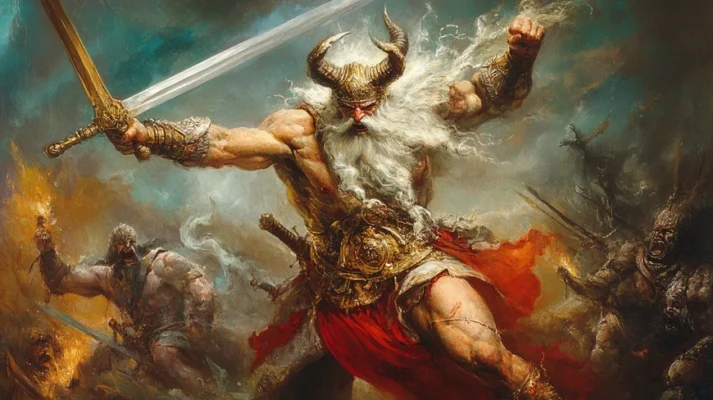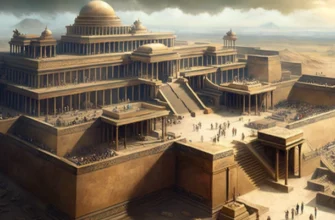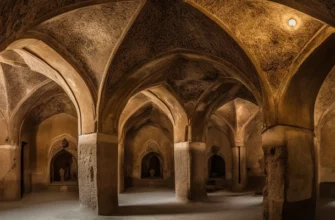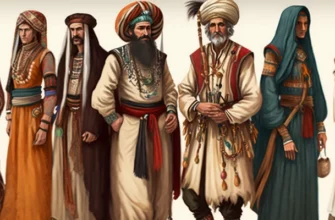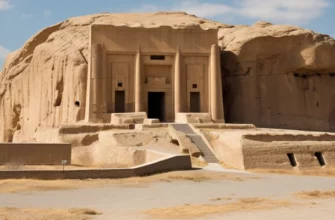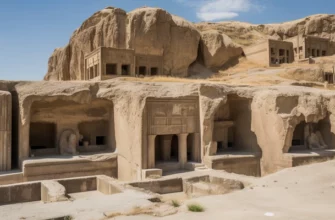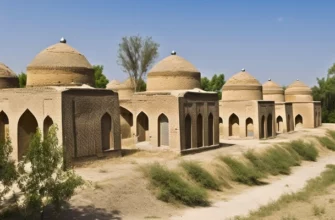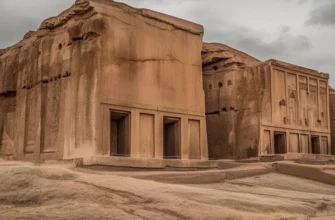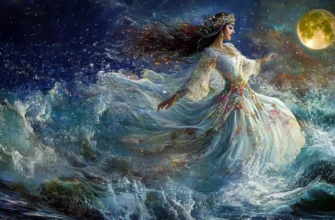Verethragna is an important figure in ancient Iranian mythology, reflecting the concept of strength and struggle. His cult was widespread in Zoroastrianism and early Iranian religious contexts.
Verehragna, also known as Varahragna, was a popular deity among Iranians as far back as the Achaemenid period. His name translates as “Victor,” and he is associated with war, victory, and protection.
In Iranian mythology, Verehragna is the deity of struggle and strength. He is often depicted as a warrior fighting demons and evil. His myths emphasize his role in maintaining order and fighting for justice.
The cult of Verethragna was important in the religious practices of the ancient Iranians. His worship included rituals symbolizing the fight against darkness and the support of light. In Zoroastrianism, his worship was part of the struggle between good and evil.
Verethragna has left a significant mark on Iranian culture, particularly in literature and art. His image has often been used to symbolize strength and victory, and he continues to attract the attention of researchers and cultural figures to this day.
Vahram remains one of the most interesting and significant figures in ancient Iranian mythology. His cult and myths reflect profound aspects of Iranian religious and cultural heritage, providing valuable material for contemporary research.
Origin and history
Verethragna, or Varahraagna, is one of the oldest divine figures in Iranian mythology, dating back to the pre-Achaemenid period. His name comes from an ancient Iranian word meaning “victor.” His cult probably originated in the middle of the second millennium BC and reflects the religious beliefs of early Iranian tribes.
The first documented mention of Verethragna is found in the texts of the Avesta canon, the main scripture of Zoroastrianism. In these texts, he is mentioned as one of the “Yehmanis” — deities who promote good and fight demons.
According to Zoroastrian beliefs, Verethragna was one of the deities who stood on the side of Ahura Mazda, the supreme god. His role was to fight against the evil represented by Ahriman (Angra Mainyu). His epithets and cult included rituals symbolizing victory over darkness and support for order.
Over time, the cult of Verethragna began to spread westward to the Roman and Greek empires. It was integrated into Roman religious practice as the god of war and victory, further expanding its influence on cultural and religious heritage.
Today, Verethragna remains an important figure in the history of Iranian religions and cultures. His image is often used to study the ancient beliefs and social structures of Iranian civilizations.
Role in Ancient Iran
Verehta, or Varahra, played a key role in the religious and social life of ancient Iran. His cult was deeply integrated into the religious practices of the Iranians and reflected important aspects of their beliefs.
In ancient Iran, Varahamihira was recognized as a deity of war and protection. His depiction as a warrior fighting demons and evil forces symbolized the struggle for justice and the maintenance of order. This corresponded to the general ideal of victory over evil, which was important to Iranian tribes and kingdoms.
The cult of Verethragna included various religious rituals that emphasized his role as protector and victor. The rituals were often intended to secure divine assistance in military campaigns or in the fight against enemies. They also included sacrifices and prayers that demonstrated loyalty and devotion to the deity.
Verethragna’s influence extended to the political and social aspects of ancient Iranian life. Rulers often used his image to legitimize their power and boost the morale of their troops. The name Verethragna became a symbol of victory and power, influencing political stability and social hierarchy.
The cult of Verethragna was not limited to Iranian territories. It spread to other cultures and civilizations, particularly within the Roman Empire. This testifies to the widespread recognition and influence of Verethragna as a deity of struggle and victory, which extended beyond the Iranian cultural context.
Thus, Verethragna was not only an important religious deity, but also a key symbol of strength and protection in ancient Iran. His role in religious rituals and social life emphasized the importance of struggle and victory in Iranian culture.
Mythological aspect
Verehta, or Varahra, is a central figure in Iranian mythology, and his image and myths reflect important aspects of ancient Iranian religion and worldview.
Main myths and legends
Verehta is often depicted in Iranian mythology as a powerful warrior fighting demons and darkness. Here are some key aspects of his mythology:
The Battle with Dahaka: One of the most famous myths involves Verethragna’s battle with the demonic monster Dahaka. Dahaka, symbolizing chaos and evil, was a dangerous enemy, and Verethragna was chosen to fight him. The victory over Dahaka symbolized the triumph of light over darkness.
Symbolic meaning: Verethraгна is associated with the concept of strength and victory. In many myths, he is presented as a deity who protects people and their homes from external threats and evil. His powers are often equated with the forces of nature, which can be used to maintain order and justice.
Interaction with other deities
In Iranian mythology, Verethragna interacts with several other deities:
Ahura Mazda: As one of the main deities in Zoroastrianism, Ahura Mazda is the supreme god with whom Verethragna cooperates in the fight against the forces of evil. Together, they represent the dualism of good and evil, with Verethragna embodying strength and struggle.
Angra Mainyu (Ahriman): As the adversary of Ahura Mazda, Angra Mainyu is the deity of darkness and evil. Verethragan acts as one of the main fighters against Angra Mainyu and his demonic forces. His myths often include struggles against demons and dark forces that embody crime and chaos.
Verethragan is often depicted as a warrior armed with a sword or spear, fighting monsters or demons. This symbolizes his role as a protector and victor. In some depictions, he may be accompanied by a horse or other symbol of power.
The mythological aspect of Verethragna has had a significant influence on Iranian culture, literature, and art. His myths and legends have been used to convey moral and religious lessons, as well as to emphasize the importance of fighting for justice and defeating evil.
Thus, Verethragna is an important mythological figure who personifies strength, struggle, and victory in ancient Iranian culture, and his myths continue to be an important source for understanding Iranian religious beliefs and worldview.
Major myths and legends
Vahram, or Varahram, is a key figure in Iranian mythology, and many myths and legends are associated with his image. The major myths and legends about Vahram emphasize his role as a deity of struggle, victory, and protection.
The myth of the struggle with Dahak
One of the most significant myths about Verethragna describes his struggle with the demonic monster Dahak (or Zohak). Dahak was a terrifying monster that symbolized chaos and evil. He had three heads and six eyes, and was believed to have absorbed the life force of humans and brought them suffering.
The essence of the myth: Verethragna was appointed by the gods to fight Dahak. Legends describe how Verethragna defeated this monster in a fierce battle that symbolized the triumph of order over chaos. The victory over Dahak represented the protection of humanity and the maintenance of cosmic order.
The myth of Verethraгна and Angra Mainyu
In another important myth, Verethraгна participates in the fight against Angra Mainyu (Ahriman), the supreme demon of evil in Iranian mythology.
The struggle for light: Angra Mainyu represents the power of darkness and evil, and his influence threatens order and justice. Verethraгна, as a warrior of the god Ahura Mazda, actively fights against Angra Mainyu and his servants. Myths describe how Verethragna fights the demons who serve Angra Mainyu in order to uphold light and well-being in the world.
The myth of Verethragna’s gifts
In some myths, Verethragna is described as a deity who bestows gifts and blessings upon humans, especially in the context of military campaigns and battles.
Divine protection: Verethragna was a loyal protector of warriors and heroes. He was believed to grant his devotees the strength and courage necessary to achieve victory in battle. His blessing was essential for ensuring success and protection in combat.
Myth of Victory and Protection
Veretragna also embodies the ideas of victory and protection, not only in the context of war, but also in everyday life.
Protection from evil: Myths describe Veretragna as a deity who protects people from evil spirits and dangers. His role in these legends emphasizes the importance of fighting negative forces to maintain order and well-being in the world.
Thus, the myths and legends about Verethragna reflect his multifaceted role as a warrior, protector, and divine fighter for justice. They demonstrate the importance of fighting evil and maintaining order in ancient Iranian culture and religion.
Interaction with other gods
In Iranian mythology, Verethraгна, or Varahraгна, interacts with several important gods who play a key role in religious beliefs and rituals. These interactions emphasize his role in fighting the forces of evil and maintaining cosmic order.
Interaction with Ahura Mazda
Ahura Mazda (or Ormuzd) is the supreme god in Zoroastrianism and the main opponent of evil. Verethragna’s interaction with Ahura Mazda is one of the most important in Iranian mythology:
Divine support: Verethragna is one of Ahura Mazda’s chief servants and plays an important role in the fight against the forces of Angra Mainyu (Ahriman). Ahura Mazda gives Verethragna strength and divine support to fight demons and evil. In this context, Verethragna acts as a warrior who carries out the divine plan to fight for justice.
Ritual functions: In religious practices, Verethraгна is often associated with rituals that promote order and victory over evil. Ahura Mazda and Verethraгна work together to ensure success in military campaigns and protect the world from the threats of evil.
Interaction with Angra Mainyu (Ahriman)
Angra Mainyu (Ahriman) is the supreme demon of evil, and Verethraгна plays an important role in the fight against him:
Fighting demons: Myths often describe how Verethraгна fights the demons who serve Angra Mainyu. These battles symbolize the struggle between good and evil, and Verethraгна acts as a hero who restores order and justice to the world.
Victory over darkness: Verethraгна not only opposes demons, but also actively defeats them, thus ensuring the victory of light over darkness. His struggle with Angra Mainyu emphasizes his role as a protector and warrior of light.
In addition to his interaction with Ahura Mazda and Angra Mainyu, Verethraгна is also significant in the context of other deities and the Iranian religious system:
Ashvin and Hvarna: Ashvin is the god of victory, while Hvarna (or Huran) personifies divine light and glory. Verethragana is often associated with these deities in the context of struggle and victory. Their interaction emphasizes the importance of preserving light and order throughout the world.
Mithra: Mithra, the deity of treaties and light, is sometimes depicted as an ally of Verethraгна. Together, they represent two aspects of the divine order — struggle and the maintenance of justice.
As part of the divine pantheon of Iranian mythology, Verethraгна plays a key role in maintaining cosmic order and fighting chaos. His interaction with other deities shows the complexity and depth of the ancient Iranians’ religious ideas about the struggle between good and evil.
Thus, Verethragan’s interaction with other deities emphasizes his important role in the religious system of ancient Iran, where he acts as the main fighter for order, justice, and victory over evil.
Verehta, or Varahra, had a significant religious role in ancient Iran, especially in the context of Zoroastrianism. His cult and religious practices reflected important aspects of Iranian beliefs, particularly the concepts of struggle, victory, and protection.
The cult of Verehta was an important part of the religious life of the Iranians:
Rituals of war and victory: Verethraгна was often associated with war and victory. Believers turned to him with requests for protection and support in military campaigns. Rituals included sacrifices, prayers, and special ceremonies designed to secure divine assistance and ensure success in battle.
Celebrations and rites: Special holidays and rites were dedicated to Verethragna, celebrating his role as a deity of protection and struggle. These holidays were often accompanied by ritual dances, songs, and sacrifices, emphasizing his importance in the religious life of the community.
Religious texts and images
Avestan texts: Verethragna is mentioned in the Avestan canon, the main scripture of Zoroastrianism. In these texts, he is presented as an important warrior of the divine order, fighting for justice and maintaining cosmic order.
Iconography: In images and religious art, Verethragna is often depicted as a warrior with a sword or spear, fighting demons. This reflects his role as an active fighter for order and victory over evil.
Ahura Mazda: As a servant of Ahura Mazda, Vahram plays an important role in the struggle against the forces of Angra Mainyu (Ahriman). He supports Ahura Mazda’s divine plan, which seeks to preserve light and order in the universe.
Supporting well-being: Verethragna was also considered the patron of people fighting for justice and protection from evil. His divine support ensured not only military success but also the general well-being of the community.
Political legitimization: The authority of the rulers of ancient Iran was often associated with Verethragna, who was used to legitimize their power. Rulers could turn to Verethragna for divine support in their military and political endeavors.
Social order: As a deity symbolizing order and justice, Verethragna also influenced social notions of rightness and morality. His cult emphasized the importance of fighting for justice in society.
Thus, Verethragna’s religious role in ancient Iran was multifaceted and important to religious, social, and political life. His cult reflected key aspects of beliefs about the struggle for justice, protection, and victory over evil.
The Cult of Verethragna
The cult of Verethragna, or Varahragana, was an important part of the religious practice of ancient Iran, especially in the context of Zoroastrianism. His worship included rituals, festivals, and ceremonies that emphasized his role as a deity of struggle, victory, and protection.
Key aspects of the cult
Rituals and sacrifices:
Military rituals: Since Verethragna was a deity of war and victory, many rituals were aimed at obtaining his blessing for success in battles and military campaigns. These rituals included prayers, animal sacrifices, and special rites intended to secure divine support.
Sacrifices: As part of the cult of Verethragna, sacrifices such as horses or large animals were often made in rituals. Sacrifices were an important aspect of ritual practice and were intended to obtain blessings and support from the deity.
Holidays and rituals:
Holidays: Veretragna was celebrated as part of religious holidays and rituals that commemorated victory and struggle. These holidays included ritual dances, songs, and special ceremonies that emphasized his role as a deity of victory and protection.
Rites: Rites of worship to Verethragna often included symbolic acts intended to show devotion and reverence to the deity. These could include special prayers and purification rites.
Images and Symbols
Iconography: Verethragna was often depicted as a warrior armed with a sword or spear, fighting demons or monsters. This symbolized his role as an active fighter for justice and protection against evil.
Symbols: In religious practices, the iconography of Verethragna included symbols of strength and victory, such as images of horses or weapons.
Zoroastrian texts: In the Avestan texts, Verethragna is described as an important servant of Ahura Mazda, assisting in the fight against demons and the forces of evil.
His role in Zoroastrianism emphasizes the importance of fighting for light and justice.
Moral lessons: The cult of Verethragna also conveyed moral lessons about the importance of fighting for justice and victory over evil. This influenced the ethics and behavior of the people who worshipped him.
Legitimization of power: The rulers of ancient Iran often used the cult of Verethragna to legitimize their power and boost the morale of their troops. Appealing to Verethragna for divine support was considered important for achieving political and military goals.
Social role: The cult of Verethragna emphasized the importance of fighting for order and justice in society. This influenced social ideas about right and wrong and morality.
Thus, the cult of Verethragna was an important part of the religious and social life of ancient Iran. It reflected key aspects of beliefs about struggle, victory, and protection, and its rituals, festivals, and ceremonies were important for maintaining divine order and justice.
Rituals and Ceremonies
The cult of Verethragna in ancient Iran was associated with various rituals and ceremonies that were intended to ensure divine support in the struggle for victory, protection, and order. Here are some of the main rituals and ceremonies associated with the worship of Verethragna:
Military rituals
Sacrifices for success in war:
Sacrifices: Believers made sacrifices, such as horses, large animals, or other valuable gifts, in order to receive Verethragna’s blessing before important military campaigns. Sacrifices were a symbol of devotion and a desire to receive divine support in battle.
Prayers: Before the start of a war or major battles, special prayers were held to ask Veretragni for protection and success. Prayers could include requests for courage and strength for the warriors.
Purification rituals:
Purification of the army: Before important military campaigns, purification rituals were held to prepare the warriors for battle. This could include ritual washings, prayers, and symbolic acts of purification intended to ensure spiritual readiness and protection.
Holidays and rituals
Holidays in honor of Verethragna:
Festivals: Special holidays and festivals were held in honor of Verethragna, celebrating his role as a deity of victory and protection. These festivals included ritual dances, songs, and musical performances that glorified Verethragna and his achievements.
Festive rites: During the festivals, rites were performed that included special ceremonies in which priests and believers participated. The selected rituals were intended to emphasize Verethragna’s importance to the community.
Worship rituals:
Prayers and supplications: Daily supplications and prayers to Veretragna included requests for protection, victory, and blessings. Prayers could be part of religious ceremonies or individual practices.
Ritual dances: Religious festivals and ceremonies often featured ritual dances symbolizing fighting spirit and devotion to Veretragna. The dances were performed as part of festive processions or ceremonies.
Purification rituals:
Purification of places: The purification of sacred places or places of worship of Veretragni took place through special rites that included ritual washing and cleansing of the space. This was intended to create a sacred environment for worship.
Purification of individuals: Purification rites for individuals participating in rituals included symbolic acts such as washing and wearing clean clothes, which were intended to ensure their spiritual purity.
Protection rites:
Protection of homes and communities: Special rites were intended to provide protection from evil forces and dangers. This could include placing amulets or performing protective rituals in homes and public places.
Ritual actions: Some ritual actions were intended to provide divine protection for people and areas that were important to the community.
The rituals and rites of worship of Veretragni also had an impact on social and cultural practices:
Social functions: Rituals and ceremonies performed in honor of Verethragna helped strengthen social bonds and fostered a collective spirit within the community.
Cultural traditions: The cult of Verethragna left its mark on the cultural traditions and arts of ancient Iran, influencing the visual arts, literature, and music.
Thus, the rituals and ceremonies of Verehragh worship were important to the religious and social life of ancient Iran, highlighting his role as a deity of struggle, victory, and protection.
Impact on culture
The cult of Verehragh had a significant impact on the culture of ancient Iran. His worship not only shaped religious beliefs, but also influenced art, literature, social practices, and political structures.
Visual Arts:
Iconography: Verethragna was often depicted in art as a warrior armed with a sword or spear, fighting demons or monsters. This image emphasized his role as a deity of struggle and victory.
Symbolism: His images included symbols of strength and courage, such as depictions of horses or weapons. These symbols were used not only in religious art, but also in decorative elements such as jewelry and textiles.
Architecture:
Shrines and temples: The architecture of temples and shrines dedicated to Verethragna reflected his importance in religious life. Architectural elements could include frescoes, sculptures, and reliefs depicting scenes from his myths and legends.
Literature and mythology
Mythological texts:
Avestan writings: In the Avestan texts, sacred to Zoroastrianism, Verethragna is described as an important servant of Ahura Mazda, and his myths play a key role in religious teachings. These texts shaped cultural ideas about struggle, justice, and order.
Legends and epics:
Epic poems: Legends about Verethragna were often included in epic poems and heroic tales. These works not only recounted his heroic deeds, but also served as moral and ethical lessons for listeners.
Holidays and rituals:
Social events: Holidays and rituals in honor of Verethragna strengthened social bonds and shaped the collective spirit of the community. They became an important part of Iranian cultural life, creating special traditions and rituals.
Ethical principles: Myths and rituals associated with Verethragna conveyed moral lessons about the importance of fighting for justice, order, and protection from evil. These lessons influenced social norms and people’s behavior.
Conclusion
The cult of Verethragna, or Varahragna, is an important aspect of the religious and cultural heritage of ancient Iran. As a deity of struggle, victory, and protection, Verethragna had a significant influence on the religious practices, art, literature, and social structures of the Iranians. His cult included various rituals and ceremonies that emphasized his role as a deity who ensures victory and order.
Religious role: Verethragna played a key role in the religious beliefs of ancient Iran, serving as a deity of struggle and victory. His cult included rituals and ceremonies that were intended to ensure divine support in wars and maintain order.
Cultural influence: The cult of Verethragna had a significant influence on the art, literature, and social practices of ancient Iran. His images and symbols were used in art, and myths and legends about his exploits shaped cultural ideas about justice and order.
Social and political aspects: The cult of Verethragna influenced social norms and political structures, helping to legitimize the authority of rulers and strengthen the collective spirit of the community through festivals and rituals.
Deeper study of mythology: Further research into the myths and legends of Verethragna may help to better understand his religious and cultural context, as well as his connection to other deities and religious ideas in ancient Iran.
Archaeological finds: Archaeological excavations of shrines and temples dedicated to Verethragna may provide new information about the material culture and ritual practices associated with his cult.
Comparative studies: Comparing the cult of Verethragna with the cults of other deities of struggle and victory in different cultures may provide new insights into its universal aspects and specific features characteristic of ancient Iran.
Study of influence on neighboring cultures: Research into the influence of the cult of Verethragna on neighboring cultures and religions can help to understand how its ideas and practices were adapted and modified in the context of other civilizations.
Thus, the study of the cult of Verethragna opens up new opportunities for understanding the religious, cultural, and social aspects of ancient Iran, as well as its interrelationships with other cultures and religious traditions.
